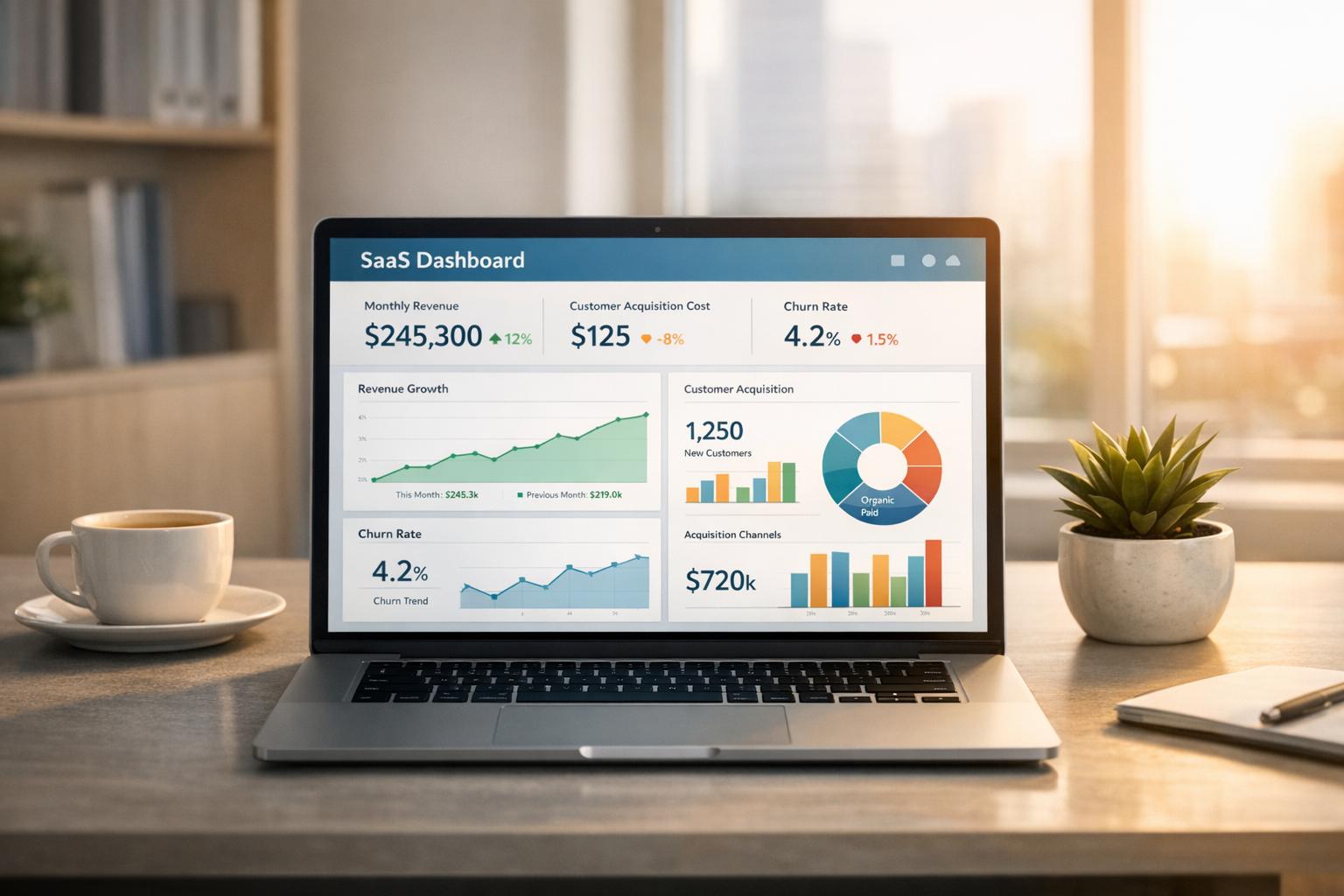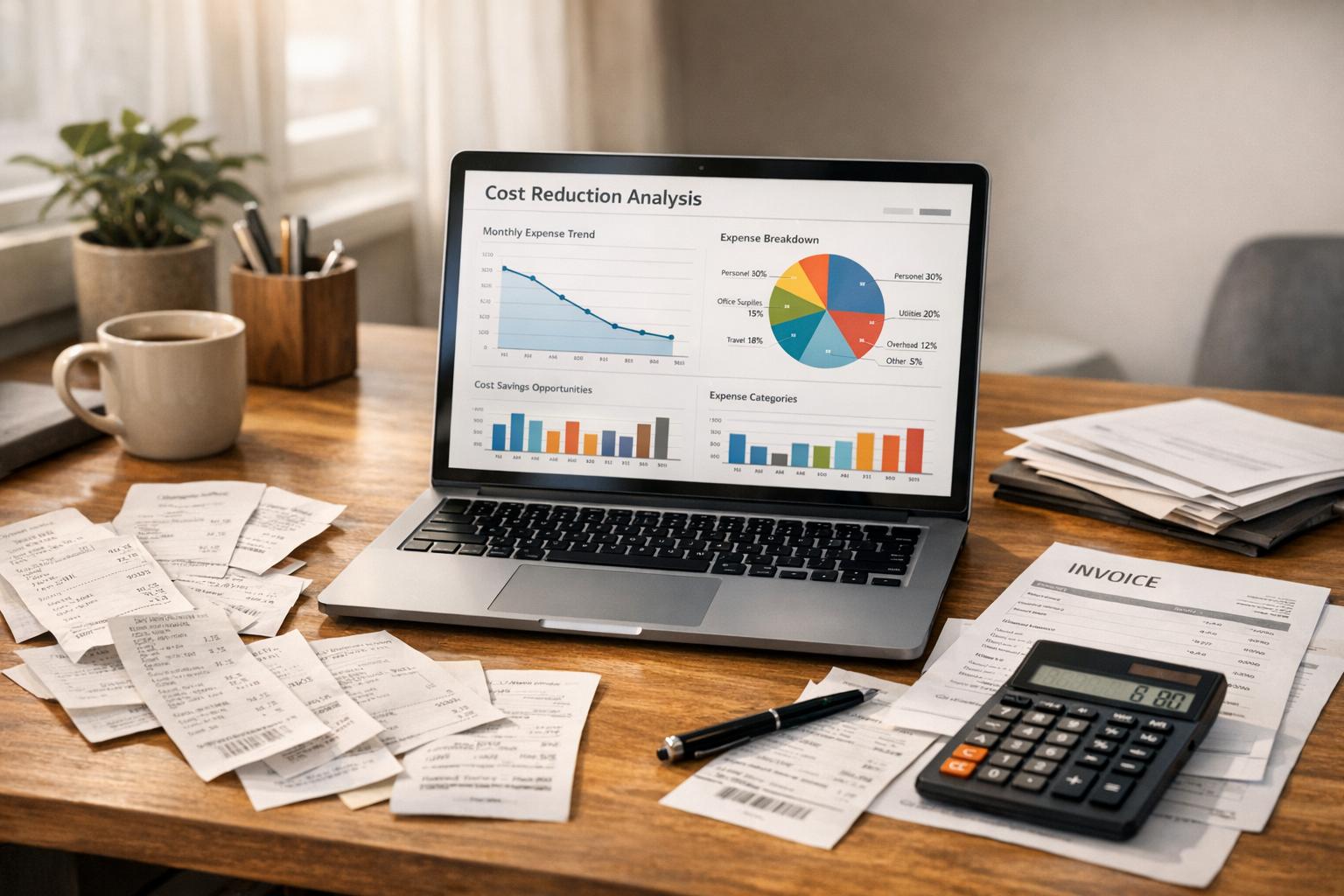SaaS Burn Rate Benchmarks by Revenue Stage

Burn rate is how quickly your SaaS company spends cash reserves to fund operations. It's critical to growth, especially as 29% of startups fail due to running out of cash. Here's what you need to know:
-
Burn rate types:
- Gross burn rate: Total operating expenses.
- Net burn rate: Cash outflow minus revenue.
-
Burn multiple: A measure of efficiency. Calculated as net burn ÷ net new ARR.
- Below 1.5: Efficient.
- Above 2.0: Risky overspending.
Benchmarks by ARR Stage:
- $1M–$5M ARR: Burn multiple 1.5x–2.5x. Focus on product-market fit and controlled spending.
- $5M–$20M ARR: Burn multiple 1.2x–2.0x. Prioritize scaling proven strategies.
- $20M+ ARR: Burn multiple 1.0x–1.5x. Balance growth with profitability.
Key Factors:
- Customer Acquisition Cost (CAC): Rising costs can hurt efficiency. Shift to content and referrals.
- Net Revenue Retention (NRR): Higher retention reduces reliance on new customers.
- Operational Efficiency: Automate processes, audit expenses, and monitor cash flow.
Tracking tips: Use real-time dashboards, weekly accounting, and scenario planning to stay on track. Align burn rates with benchmarks to improve cash flow, attract investors, and grow sustainably.
Burn Rate Benchmarks by Revenue Stage
Let’s dive into the benchmarks for burn rates across different revenue stages. SaaS companies face unique financial challenges depending on their annual recurring revenue (ARR). What’s considered healthy spending for a company at $2M ARR looks very different from one at $15M ARR.
To measure capital efficiency, focus on stage-specific burn multiples.
Early Stage ($1M–$5M ARR)
For early-stage SaaS companies, burn multiples typically range between 1.5x and 2.5x. This means they’re spending $1.50 to $2.50 for every dollar of new ARR they bring in. While these numbers might seem steep, they reflect the costs of building foundational systems and proving product-market fit.
At this stage, the primary challenge is managing the balance between growth investments and staying afloat. Spending is often directed toward product development, early marketing experiments, and building a core team. The focus should be on customer discovery and refining the product, all while grappling with higher fixed costs.
A common misstep for early-stage companies is scaling sales and marketing efforts too soon - before confirming the product resonates with the target market. This can lead to burn multiples exceeding 3.0x, which drains cash reserves without delivering sustainable growth.
The most efficient companies in this stage prioritize customer discovery, fine-tuning their product, and developing repeatable sales processes. They avoid costly channels like paid advertising until they’ve proven strong unit economics through organic growth or direct sales.
Growth Stage ($5M–$20M ARR)
For growth-stage companies, the target burn multiple narrows to 1.2x to 2.0x. At this point, product-market fit is established, and the focus shifts to scaling proven go-to-market strategies. Operational priorities transition from experimentation to execution and optimization.
With larger revenue streams, spending decisions carry greater weight. Hiring mistakes, for example, can have a bigger impact at this stage. To avoid inefficiencies, advanced financial planning, real-time tracking, and cohort analysis become critical tools.
The most efficient growth-stage companies keep burn multiples closer to 1.2x by optimizing customer acquisition costs and improving net revenue retention. Automation of operational processes and enhancements to gross margins - through better product design and pricing strategies - also play a key role.
Scale Stage ($20M+ ARR)
When SaaS companies reach the scale stage, burn multiples typically fall between 1.0x and 1.5x. At this level, the focus shifts to balancing growth with profitability.
Operational challenges become more complex. Companies often expand into new markets, launch additional products, or build enterprise sales teams. These initiatives require significant upfront investments but are expected to deliver predictable returns based on the company’s established business model.
Efficiency becomes critical. Larger organizations face rising coordination costs, slower decision-making, and potential dilution of company culture. Successful scale-stage companies invest in robust systems, streamlined processes, and leadership development to sustain growth without a proportional increase in complexity.
Investor expectations also evolve at this stage. While early-stage investors may tolerate higher burn multiples to accelerate growth, scale-stage investors prioritize sustainable unit economics and clear paths to profitability. This means decisions about burn rates must carefully balance growth ambitions with financial discipline.
Companies closer to a 1.0x burn multiple are focused on efficiency and profitability, while those near 1.5x are still aggressively pursuing growth opportunities. Where your company falls within this range depends on market conditions, competition, and strategic goals.
These benchmarks provide a foundation for exploring the additional factors that influence burn rates.
Key Factors That Impact SaaS Burn Rate
The revenue stage provides a starting point, but there are specific factors that truly shape how efficiently SaaS companies manage their cash. Understanding these elements is crucial for making smart financial decisions, especially for growth-stage businesses.
Customer Acquisition Cost (CAC) Trends
Customer acquisition costs (CAC) play a huge role in determining burn rate efficiency across all revenue stages. Rising digital ad expenses, tougher competition for talent, and longer sales cycles have pushed CAC higher for many SaaS companies. This means businesses are often spending more to generate the same number of qualified leads. For enterprise-focused SaaS, extended sales cycles further inflate costs, as companies incur ongoing expenses for sales teams, tools, and overhead while waiting for revenue to arrive.
To combat these rising costs, many companies are shifting their strategies. Instead of relying heavily on paid ads, they’re investing in alternatives like content marketing, forming strategic partnerships, and launching referral programs. While these approaches may take longer to scale, they often come with lower upfront costs.
Expanding into new international markets adds another layer of complexity. Localization efforts, unfamiliar marketing landscapes, and the time needed to build trust with new audiences often lead to higher acquisition costs in these regions.
Since CAC directly influences customer retention, it’s essential to monitor its impact on overall burn rate.
Net Revenue Retention (NRR)
Net revenue retention (NRR) reflects how much existing customers contribute to revenue growth, making it a key metric for burn rate efficiency. Companies with strong NRR rely less on acquiring new customers to hit growth targets, which helps keep cash burn under control.
NRR tends to fluctuate depending on a company’s stage. Early-stage SaaS businesses may see slower improvements as they focus on growing their customer base. On the other hand, mature companies often achieve higher retention rates thanks to established customer success programs and deeper product integration.
Expansion revenue, often tied to quarterly reviews or annual contract renewals, can create uneven cash burn throughout the year. Managing this variability requires careful cash flow planning. Additionally, during economic downturns, reducing customer churn becomes even more critical. Retaining customers minimizes the need for costly acquisition efforts.
Product-led growth strategies - where users naturally adopt features without heavy sales involvement - can also boost NRR while keeping costs low. This approach often leads to more efficient burn rates.
Operational Efficiency
Operational efficiency is another major factor in managing burn rates. It covers everything from technology infrastructure to team productivity and can make or break a company’s financial health.
Switching to modern, integrated tools can significantly cut costs compared to sticking with outdated systems. This shift not only reduces overhead but also improves overall burn rate efficiency.
Automating financial processes is another way to save. By minimizing manual work, companies can improve cash flow visibility and speed up decision-making.
Team structure also plays a big role. Smaller, early-stage companies often benefit from lean, focused teams, while larger organizations need clear processes, strong communication tools, and effective performance management to avoid inefficiencies that come with scaling.
Conducting regular vendor audits is another smart move. Reviewing subscriptions, renegotiating contracts, and eliminating unnecessary services can trim expenses without stalling growth.
Finally, having real-time insight into financial performance is a game-changer. Advanced financial planning tools can quickly identify inefficiencies, allowing companies to adjust spending before it becomes a problem. This proactive approach often separates businesses that consistently hit their burn targets from those that struggle with unexpected cash flow issues.
When these factors - CAC, NRR, and operational efficiency - are optimized together, their combined impact can dramatically improve burn rate efficiency. Companies that tackle these areas simultaneously are better equipped to manage cash flow and achieve healthier financial outcomes.
How to Monitor Burn Rate Metrics
Once you've set your stage-specific benchmarks, keeping a close eye on burn rate metrics becomes crucial. For SaaS companies, proper tracking systems and processes are the backbone of financial stability. Without them, unexpected cash flow problems can arise. The goal? Build systems that provide real-time insights and empower quick decisions when adjustments are necessary. These tools are essential for staying ahead of potential financial challenges.
Real-Time Dashboards and Reporting Systems
Automated dashboards have become a go-to tool for SaaS companies looking to monitor burn rate metrics. These dashboards pull data from various sources like accounting, CRM, and payroll systems to offer a unified view of cash flow.
Key metrics to monitor include:
- Gross burn rate and net burn rate
- Runway calculations (how long your cash will last)
- Burn multiple (the ratio of net cash burned to net new ARR)
Displaying these metrics at both company-wide and departmental levels helps leaders quickly identify inefficiencies. Automated updates make it easier to spot issues like sudden spending increases or unexpected dips in revenue. Plus, dashboards with trend analysis features allow for monthly or quarterly comparisons. This helps identify seasonal patterns and evaluate how specific growth strategies impact cash flow.
Weekly Accounting Systems and Scenario Planning
Switching from monthly to weekly financial tracking can completely change how SaaS companies manage their burn rates. Weekly tracking provides more timely insights, allowing for quicker course corrections and better alignment with long-term goals.
Weekly reviews of KPIs ensure that every department is on the same page when it comes to burn rate targets. By breaking down the company vision into actionable, daily steps, teams can address small issues before they grow into larger problems.
This frequent cadence also sharpens key metrics and provides a clearer picture of financial health. Using historical data, companies can create accurate forecasts and set realistic goals that align with their growth strategies. With up-to-date information, scenario planning becomes much more effective. Companies can model various growth paths, account for market conditions, and adjust funding timelines as needed.
When combined with monthly planning cycles, weekly tracking ensures that financial issues are caught early and resolved promptly, leading to stronger overall performance.
Working with Financial Advisory Services
Many SaaS companies also turn to financial advisory services to enhance their burn rate management. These advisors bring valuable expertise, especially for growth-stage companies navigating the complexities of scaling operations.
Specialized firms like Phoenix Strategy Group offer tailored support, including fractional CFO services, FP&A systems, and integrated financial models. Their tools, such as the Weekly Accounting System and Monday Morning Metrics, ensure consistent tracking and provide leadership with real-time insights into cash flow trends.
Advisors also help build advanced forecasting models that account for SaaS-specific challenges like revenue recognition and seasonal fluctuations. These models often include multiple scenarios, allowing companies to prepare for different market conditions or funding outcomes.
Additionally, working with experienced financial advisors improves communication with investors. Clear, detailed financial reports and well-articulated burn rate trends build trust with current backers and can make a company more attractive during future funding rounds.
sbb-itb-e766981
Using Burn Rate Benchmarks for Decision-Making
Once you’ve established solid tracking systems, the next step is to put those benchmarks to work. These benchmarks aren’t just numbers - they’re tools to help guide decisions that promote steady, sustainable growth. For SaaS companies, leveraging these benchmarks means setting realistic goals, confidently engaging with investors, and making precise capital allocation choices. Essentially, benchmarks are the bridge between rapid growth and scaling with stability.
Growth Planning
Burn rate benchmarks act as a reality check when setting growth and efficiency goals. By comparing your burn multiple to industry norms for your revenue stage, you can quickly identify whether your spending is on track or needs adjustment. For instance, if your company is at $8M ARR but has a burn multiple exceeding the target of ~0.65x for the $5M–$10M ARR range, it’s time to hit pause on aggressive hiring, improve sales efficiency, and reevaluate marketing expenses. The goal? Align with the benchmark through disciplined execution.
These benchmarks also offer clear efficiency targets. For early-stage companies ($1M–$3M ARR), a burn multiple around 1.7x is typical while focusing on achieving product-market fit. As companies grow into the $3M–$5M ARR range, the target improves to about 1.0x, reflecting better operational efficiency. Beyond burn multiples, other key metrics include aiming for gross margins above 75%, CAC payback periods under 12 months, and net dollar retention above 100%. Combined, these metrics create a well-rounded framework for balancing growth with sustainability.
Once growth targets are set, benchmarks also help streamline communication with investors.
Investor Communication
Burn rate benchmarks provide a shared framework for discussing growth and financial efficiency with investors. Showing a burn multiple below 2.0x - especially at later revenue stages - signals disciplined and strategic growth, making your company more appealing during fundraising. For example, improving your burn multiple from 1.7x to 1.0x demonstrates operational maturity. Companies that time their fundraising efforts with 12–18 months of runway and benchmark-aligned burn multiples are better positioned to attract investor confidence. Regularly updating investors with benchmark-driven insights reinforces your narrative of thoughtful, scalable growth.
But benchmarks aren’t just for investor updates - they’re also essential for detailed scenario planning and smart capital allocation.
Scenario Analysis and Capital Allocation
Using real-time data alongside benchmark insights, scenario analysis helps guide capital allocation in different market conditions. Companies can model how adjustments in growth rates, spending, or market shifts impact their burn multiple and cash runway. Comparing these projections to industry benchmarks enables more informed decision-making. For example, tweaking your CAC or net revenue retention can help align your burn multiple with industry standards.
These benchmarks sharpen your capital allocation strategies. You can evaluate whether increasing marketing spend might push your burn multiple beyond acceptable limits or if hiring more sales staff aligns with efficiency goals. This method balances growth investments with long-term sustainability. Additionally, preparing for market volatility through conservative scenario planning ensures quicker responses to changes and builds confidence in your decision-making.
| Revenue Stage | Typical Burn Multiple | Capital Allocation Focus |
|---|---|---|
| $1M–$3M ARR | ~1.7x | Product-market fit validation |
| $3M–$5M ARR | ~1.0x | Operational efficiency gains |
| $5M–$10M ARR | ~0.65x | Proven channel scaling |
| $10M–$15M ARR | ~0.85x | Market expansion discipline |
| $20M+ ARR | <1.0x | Profitability preparation |
Working with financial advisory services like Phoenix Strategy Group can accelerate improvements in your benchmark performance. These experts assist with advanced scenario modeling, stage-specific target setting, and capital allocation frameworks that align with industry norms. Their expertise in FP&A systems and strategic planning ensures that companies can use benchmark data effectively for both day-to-day decisions and long-term growth strategies.
Conclusion
Keeping your SaaS burn rate aligned with benchmarks specific to your stage of growth is crucial for maintaining momentum and achieving long-term success.
These benchmarks go beyond just crunching numbers - they lay the foundation for building businesses that are not only sustainable but also appealing to investors. Currently, burn multiples below 1.0x stand out as exceptional, while those above 2.0x may indicate potential risks ahead. Staying within these ranges signals the kind of financial discipline that investors look for.
Benchmark data plays a pivotal role in shaping early-stage investments, scaling operations effectively, and preparing for profitability. For example, top-performing SaaS companies achieved an impressive 45% growth in 2023, proving that sticking to these benchmarks can deliver tangible results.
By keeping a close eye on burn multiples, you can pinpoint inefficiencies, stretch your cash runway, and strengthen your fundraising efforts. Metrics like 101% net revenue retention and 40% expansion ARR highlight how efficient capital allocation can drive success.
Partnering with experts like Phoenix Strategy Group can further streamline this process. They offer tools like advanced scenario modeling, real-time reporting, and strategic planning to ensure your financial metrics align with both immediate goals and long-term ambitions.
In today’s competitive SaaS world, success belongs to companies that combine bold growth strategies with disciplined spending - using burn rate benchmarks as their roadmap to sustainable and investor-ready growth.
FAQs
What is a good burn multiple for SaaS companies at different revenue stages, and how can they determine it?
What Is a Good Burn Multiple for SaaS Companies?
The ideal burn multiple for SaaS companies can vary based on their revenue stage and growth goals. Simply put, the burn multiple measures how effectively a company uses its cash to drive growth. It’s calculated by dividing net burn (cash spent minus cash earned) by net new ARR (annual recurring revenue).
For many SaaS businesses, a burn multiple under 2.0 is seen as a sign of efficient capital use. If the number creeps higher, it might indicate that the company is spending more cash than it should to achieve its growth. To figure out what’s right for them, companies should compare their metrics to industry benchmarks, evaluate their growth ambitions, and fine-tune their spending or revenue strategies. Prioritizing capital efficiency is key to maintaining sustainable growth and long-term financial stability.
How can SaaS companies lower customer acquisition costs and improve their burn rate efficiency?
SaaS companies can cut down on customer acquisition costs (CAC) by fine-tuning their marketing and sales efforts. This might involve leveraging targeted automation, improving lead conversion techniques, and concentrating on customer segments that bring the most value. These approaches ensure better returns on marketing investments while trimming unnecessary spending.
To enhance burn rate efficiency, businesses can explore options like renegotiating supplier agreements, switching to cost-effective infrastructure, and adopting remote work setups to reduce overhead. Additionally, speeding up the payback period for CAC and automating customer targeting can boost ROI and strengthen financial performance.
By implementing these strategies, SaaS companies can strike a balance between spending and revenue, paving the way for sustainable growth.
What is net revenue retention, and how does it affect a company's burn rate? How can businesses improve it?
Net revenue retention (NRR) is a key metric that shows how well a company retains and grows revenue from its existing customers over time. It directly impacts a company’s burn rate. When NRR is above 100%, it means the business isn’t just holding onto its customers - it’s also increasing revenue through upselling or cross-selling. This extra revenue can help cover operating costs, lower the burn rate, and contribute to steady growth.
To boost NRR, businesses can focus on a few core strategies:
- Improving customer success: Deliver top-notch support and address customer needs proactively to keep them satisfied.
- Upselling and cross-selling: Introduce upgrades or complementary products that align with your customers’ needs.
- Reducing churn: Pinpoint and resolve issues that lead to customer dissatisfaction, ensuring more clients stick around.
By emphasizing these approaches, companies can create stronger revenue streams and improve their overall financial stability.




